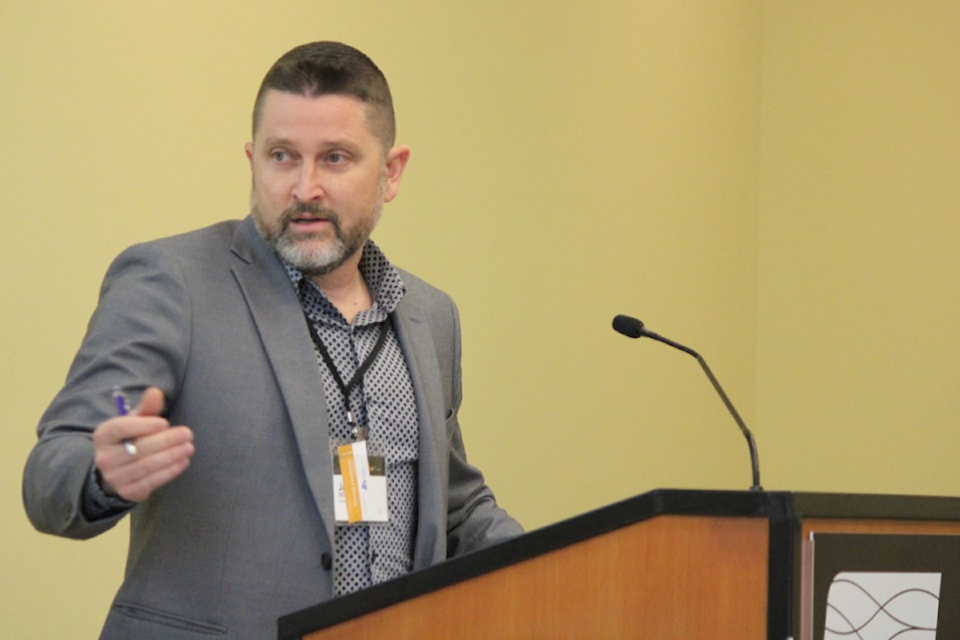More needs to be done to ensure groceries and goods are transported onto the Island more effectively, say stakeholders.
Bolstering distribution channel lines and strategies for trade were the focus of a Vancouver Island Economic Alliance summit panel Thursday, Oct. 24, at the conference centre in Nanaimo, moderated by Jason Michell, Nanaimo Port Authority vice-president of business development.
Thomas Bevan, Island Corridor Foundation chief executive officer, Chris Theeparajah, Export Development Canada senior international trade finance manager, Mario Iacobacci, economic advisory partner with Deloitte Canada and Joel Werner, DP World Canadian operations' chief operating officer, served as panellists.
Deloitte has worked with the port authority on Duke Point shipping terminal upgrades, Iacobacci said, and added that Island supply chain resilience depends on support for both storage and transloading – transferring shipments from one method of transportation to another.
There are limited inventories in different parts of the Island supply chain, he said, and the "only real answer to that is you need to increase those inventories," and possibly control costs by ensuring it's a transloading hub with goods that are potentially coming directly onto the Island.
The question, he said, is how can inventory costs be controlled and minimized, while ensuring there is support that can withstand "some of the shocks we tend to see."
"We also think that some of our ports on Vancouver Island, particularly also Duke Point … can serve as congestion relief points, an alternative trade route, congestion relief for Lower Mainland, so that you can have potentially direct port calls into Vancouver Island, combined with the short-sea shipping services to the Lower Mainland, and that could be another part of the solution," said Iacobacci.
Werner stressed the importance of establishing diverse networks that utilize different supplies and modes of transportation in the network, so that if there is an extreme weather event, for example, there is a contingency in place.
Supply chains are "an infrastructure-heavy business," he said, and continual investment is needed, as investments made 20 years ago won't pass muster in the next 20. Further, new technologies need to be leveraged and better forecasting and understanding of what's occurring with the supply chain is needed as well.
"We need to see what's arriving via marine side, and is the rail system ready to handle that?" said Werner. "Earlier this year, there was a big imbalance in the import volumes that were coming into the West Coast of Canada and the rail networks, intermodal and so on, were not prepared to handle this, so how can we leverage our different assets across there, from Vancouver Island here to the mainland, and accommodate the cargo that needs to move?"
In terms of how Vancouver Island businesses can better position themselves to access global markets, Theeparajah said being up on trends is beneficial.
"Being able to communicate what your value proposition is as a company … and also potentially having the ability to accept payment in other currencies, that's something that a lot of international buyers are looking for," said Theeparajah. "Being up to speed on certification and classifications, things like [International Organization for Standardization], fair trade, organic, these are all international certifications which have appeal in other markets."
In terms of spending on critical infrastructure upgrades that aid the growth of trade on the Island, Bevan said it is important to for the Island to lean into its strengths.
"In my old hometown, outside of Toronto, I think we can learn that one more lane doesn't work. You look at L.A., one more lane doesn't work," he said. "We need to have interconnectivity, intermodality, and that should provide dividends in an efficient way. Creating new infrastructure in places where it's not currently is extraordinarily expensive and it further dissipates that linear kind of nature that is our real advantage."
In Bevan's opinion, the most critical decision for people-making infrastructure and investments is how to complement the settlement pattern already in place.
The VIEA summit was held at the Vancouver Island Conference Centre on Oct. 23-24.



